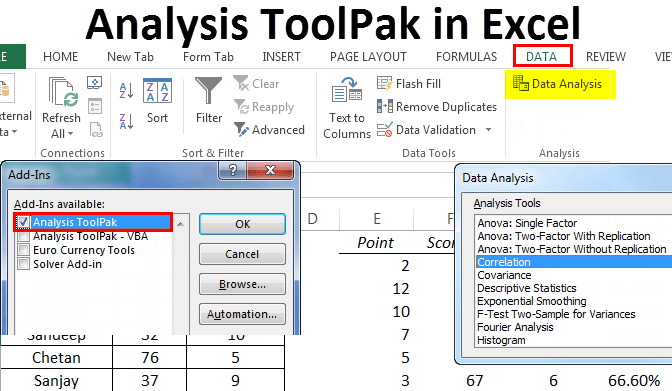

of Units sold is more, but the Actual Profits made are less. of Units on the secondary axis.Ī significant observation in the above chart is for Quarter 3 where No. You can observe the values for Actual Profits on the primary axis and the values for No. Your Combo chart appears with Secondary Axis. of Units and click OK.Ī preview of your chart appears under Custom Combination.
#EXCEL DATA ANALYSIS ADD IN SERIES#
Check the Box Secondary Axis to the right of the Series No.Clustered Column for the Series Actual Profits.The Insert Chart dialog box appears with Combo highlighted. Click Create Custom Combo Chart from the drop-down list.In such cases, you can create a combination chart with secondary axis, so that the primary axis displays one range and the secondary axis displays the other. of Units is not visible as the data ranges are varying significantly. If you use the same combination chart as before, you will get the following − Suppose you have the data on the number of units of your product that was shipped and the actual profits for the fiscal year 2015-2016 that you obtained from different regions. Creating a Combo Chart with Secondary Axis However, this type of representation does not work well when the data ranges of your two data values vary significantly. The data visualization has become better as it also shows you the trend of your results. Your Customized Combination Chart will be displayed.Īs you observe in the chart, the Target values are in Columns and the Actual values are marked along the line. The preview appears under Custom Combination.

The Change Chart Type dialog box appears.Ĭhange the Chart Type for the series Actual to Line with Markers. Click Change Chart Type in the Type group.Click the DESIGN tab under the CHART TOOLS tab on the Ribbon.

Use Vertical Columns for the target values and a Line with Markers for the actual values. In Excel 2013 and versions above, you can use Combo charts for the same purpose. It does not give a true impact on your results.Ī better way of distinguishing two types of data to compare the values is by using Combination Charts. We will create a Clustered Column Chart for these results.Īs you observe, it is difficult to visualize the comparison quickly between the targets and actual in this chart. Suppose you have the target and actual profits for the fiscal year 2015-2016 that you obtained from different regions. In this chapter, you will understand the different techniques that you can use with the Excel charts to highlight your data analysis results more effectively. Refer to the Tutorial Excel Charts for more information on chart types. Excel provides you with many chart types and you can choose one that suits your data or you can use the Excel Recommended Charts option to view charts customized to your data and select one of those.
:max_bytes(150000):strip_icc()/how-to-run-regression-in-excel-4690640-1-e3f967494342438aaedd6496a2bf95e6.png)
A chart is a visual representation of the data, in which the data is represented by symbols such as bars in a Bar Chart or lines in a Line Chart. In Excel, charts are used to make a graphical representation of any set of data.
#EXCEL DATA ANALYSIS ADD IN HOW TO#
In this chapter, you will get to know how to use Excel charts and Excel formatting features on charts that enable you to present your data analysis results with emphasis. It also leaves a good impact on your presentation style. However, if your data analysis results can be visualized as charts that highlight the notable points in the data, your audience can quickly grasp what you want to project in the data. You can display your data analysis reports in a number of ways in Excel.


 0 kommentar(er)
0 kommentar(er)
